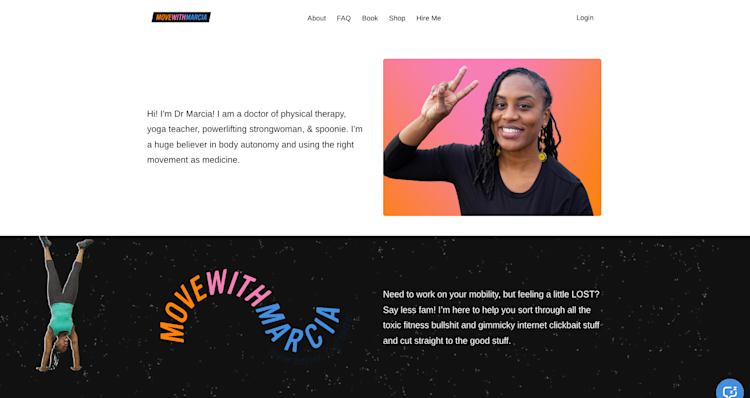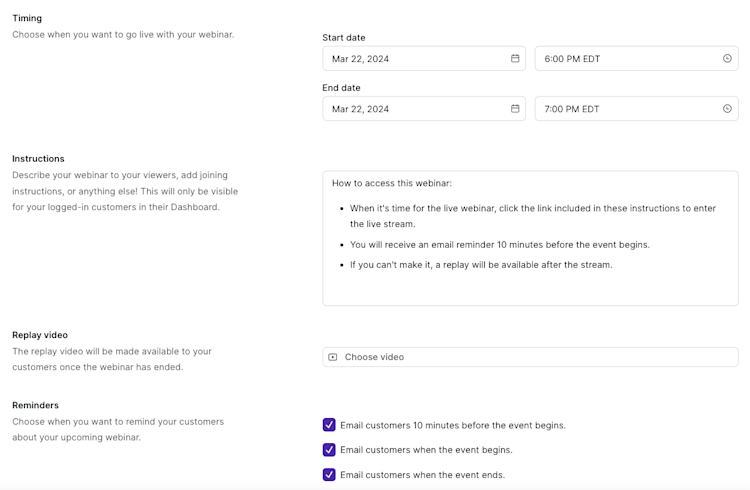While servicing your physical therapy clients in-person is effective, it can be exhausting.
Not because you don’t enjoy it, but because the more clients you meet with, the more you spread yourself thin.
Ultimately, there’s only one of you.
Avoiding entrepreneurial burnout is critical for small business owners, but it can feel darn near impossible when you’re still trying to grow.
Not to worry, though. There is a way to grow your business, serve more clients, and keep a balanced lifestyle.
In fact, there are four ways to do it.
Today, we bring you four methods for converting your offline sessions and consultations into online products, so you can scale your business.
4 ways to serve your physical therapy clients online
#1. Launch an online course
The first way to bring your physical therapy practice online is to create and sell a relevant online course that helps your audience achieve their desired results on their own time.
For example, Laura Malnati Chambers from Peak Wellness has programs to help women reconnect with their physical strength.

And Dr. Marcia Dernie provides free and affordable resources to help people move better through mobility exercises and yoga.

To plan, write, and produce your online course, the first step is to glean insights from your audience and conduct customer research.
Why start with customer research?
Naturally, your customers are the most important part of your business and will give you the answers for guiding the substance of your online course.
So, as simple as it sounds, ask them what they want to learn about for self-guided physical therapy.
Find out their biggest pain points (literally and in the marketing sense), so you can turn your course modules into steps that help them solve those pain points. This important research will inform the specific topic and content of your online course.
Then, once you have your online course topic and research under your belt, outline the structure of your course and run it by your audience.
To do this, we recommend creating a course prototype with a few modules and releasing it to beta students, as a way of gauging their reaction and then adjusting your full course curriculum accordingly.
Once this step is done and your online course content is structured with feedback, it’s time to produce your full-fledged course using a few essential online course tools, such as a video camera, microphone, editing tool, and hosting space.
This is by far the most daunting part of the process but take heart: once you’re done with this portion, the rest of the work is simple maintenance and marketing.
(Need more help getting your course off the ground? We have a 12,000+ word online course creation guide for that.)
And, as a major bonus, scaling with an online course is a breeze after you have the lion’s share of work done.
Unlike one-on-one sessions, you aren’t limited by hours in the day. You can sell to and serve limitless clients at an equally limitless rate. Whether you get 10 new customers a day or 100, you never have to put in more muscle-work on your online course content.
Of course, for some, an online course presents an undesirable level of front-loaded effort, and that’s totally fair. Our next tip is just as scalable but doesn’t take half as much grind to produce.
#2. Sell webinar sessions
Another effective way to serve your physical therapy clients online is to sell webinar sessions that, again, help your audience achieve their desired result.
(You’ll notice that’s a theme in info products.)
This is an especially great tactic for generating loyalty amongst your clients. That’s what 60% of webinars are used for, overall.
You can host and sell live or recorded webinar sessions that demonstrate to your clients how to solve their pain points.
Customer research applies here, too, where you survey your target audience to uncover insights about their biggest problems. Then, in your webinar, you simply address their top issues, provide educational value, and help your audience solve their key problem.
For instance, check out Forward Movement’s webinar that covers the basics of functional medicine.

By focusing on one core deliverable -- or result -- your webinars help position you as the expert physical therapist in your field and build you up as a credible resource and trustworthy brand.
And trust is a big deal, considering 63% of people say that without trust in the company behind a product, they’ll soon stop buying it, regardless of its reputation.
As far as promoting your webinar, be sure to promote it all the way up until your scheduled webinar time and as early as four weeks prior.
59% of registrations occur within a week of your webinar, and 17% happen the day of, so persistence is the name of the game here.
If you’re building an email list, promote your webinar to your subscribers by using product launch email templates and sending emails that announce your new webinar.
To sell your webinar, it’s as straightforward as adding any other digital product to your product page if you’re using an all-in-one platform like Podia. Just select “Webinar,” name your webinar, and hit “Create & continue” when adding your new product.

Then, you just submit details into a few pertinent form fields, like your webinar video link (powered by YouTube Live or Zoom), instructions, and pricing.

It’s worth noting that you can even bundle your webinar with other digital products since all of your digital products are managed using the same dashboard on Podia, which makes it a cinch to keep scaling your products.
But, of course, there’s no need to take my word for it. You can experience the easy-to-use dashboard yourself. Give Podia a try for free today.
The gist of it is:
Offer your audience an educational webinar that helps them solve their biggest problem. Promote your webinar using a sequence of sales emails and invite your subscribers all the way up to the day of your scheduled webinar.
However, while selling webinars are great for a single transaction, if you’re looking for a way to serve your clients over a longer period and cash in with recurring revenue, our next method may be right up your alley.
#3. Do online consultations
Another way to service your physical therapy audience online is to offer online consultations using video conferencing.
Check out how Sara Cammo from Sara Cammo Nutrition supports clients online with 1:1 coaching packages in addition to self-paced programs.

If you’re worried about how your clients will feel if you help them remotely online instead of in-person, don’t be. These days, 87% of remote users say they feel more connected to others when using video conferencing.
And as a bonus, you can get started for free.
For live video conferencing tools, check out free online tools like Zoom, Google Hangouts Meet, GoToMeeting, or Skype.
If you want to scale your live sessions, try extending your consultations to clients in a group setting.
Most video conferencing platforms let you video chat with large groups of people, so you can help multiple clients at once.
For instance, Skype allows you to host video meetings with 50 participants in each video call.
The main takeaway here is simple: Leverage online video conferencing tools, so you can serve your clients remotely online and even in group consultation sessions.
If all of the above sounded great but like more work than you have the time or patience for, then you’re going to love our last method today.
#4. Sell a downloadable info product
The fourth way to service your physical therapy clients online is to offer them an educational product in the form of an ebook or other educational digital download.
If you go the ebook route, you’ll be in good company, and for a good reason.
The number of ebook users has been on a steady rise since 2017 and is anticipated to reach 1.22 billion by 2024.
For your clients who prefer to learn by reading, this is an ideal format.
After all, people learn across a mix of visual, aural, reading and writing, and kinesthetic learning styles, so it’s wise to cater to a variety of preferred learning methods.
Not to mention, educational digital downloads are great for your audience members who prefer the self-service route.
And these days, self-service is becoming the preferred service channel, with 67% of customers preferring self-service over speaking to a representative.
Plus, like our other unconventional business ideas we share today, it’s a scalable way to serve your audience while growing your practice.
Without meaning to sound like a broken record, there’s no cap to the number of digital downloads you can sell, which means you can create your digital product once and sell it to as many clients as you can reach, with only marketing to maintain.
Now that you’re (hopefully) sold on the scalable idea, for step-by-step directions on creating and selling your ebook, follow the 11 steps inside this guide on how to create and sell an ebook from your own site.
It’s worth mentioning that, even if you don’t sell your downloadable info product, you can give it away as a lead magnet to attract a wider audience that you later convert to paying clients.
Just nurture your new contacts through a series of emails that give them value and, eventually, offer your other paid products. If you need a starting place, try these eight sales email templates.
Bottom line:
Provide your audience with educational value in written and visual form by selling them a digital download, like an ebook. You can also use it as a lead magnet for growing your subscriber list.
Convert your offline audience to online clients
Running your physical therapy practice doesn’t have to be done as a one-to-one in-person business, which may wear you out if you’re looking to expand your reach.
It can also just be plain inconvenient for everyone involved, especially in recent times.
Fortunately, there are alternatives. To sum it up for you:
-
#1. Scale your physical therapy business by selling your audience an online course that helps them achieve their desired result through structured lessons and modules.
-
#2. Help your clients online by selling an educational webinar that’s either live or recorded. You can bundle your webinar with other digital products, too.
-
#3. For short-term live sessions, use video conferencing tools, so you can help your clients remotely. Try offering 1-on-1 and group consultations.
-
#4. Sell educational digital downloads, such as ebooks, to your audience to bring them value and help them reach their goals. You can also offer digital downloads for free to expand your audience reach.
Will the adjustment be easy every step of the way? As much as I want to say yes, the truth is that it probably won’t. But will it be worth it?
That I can give a definitive yes to, both for your bottom line and your clients.



